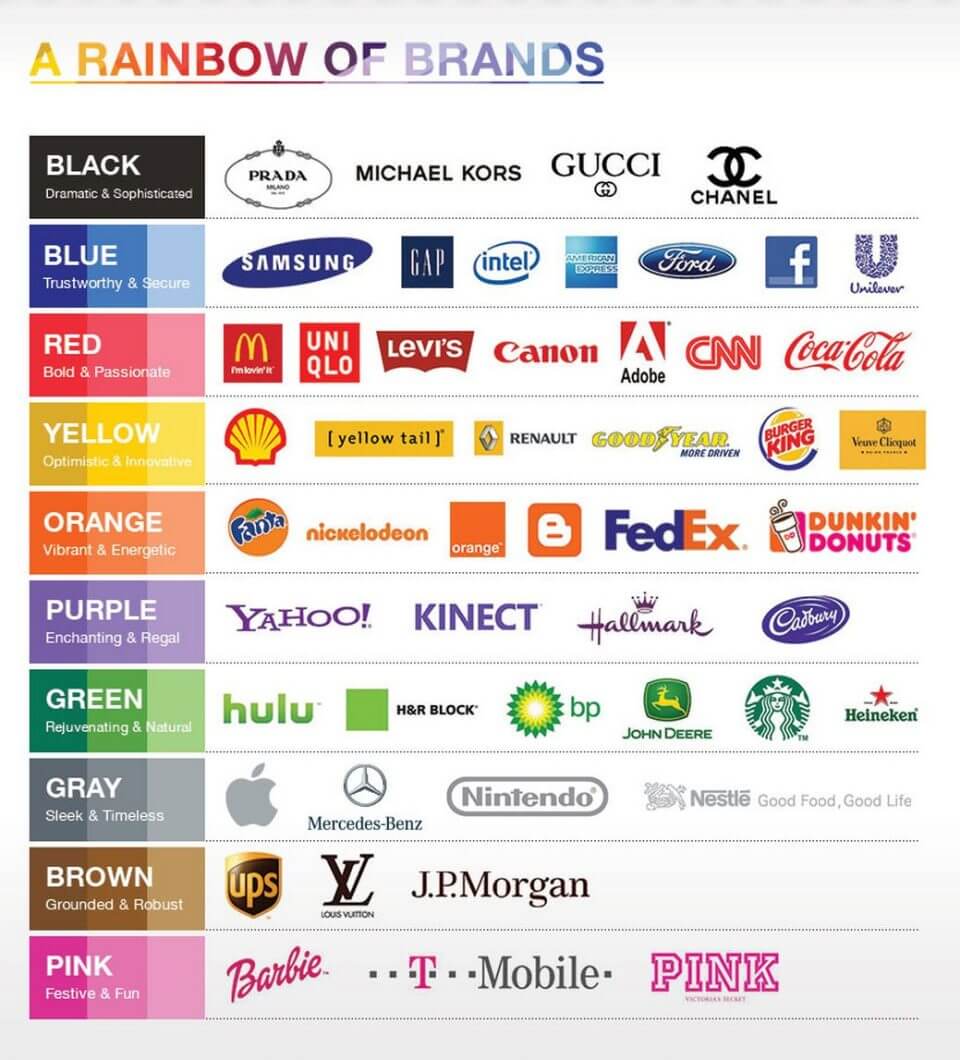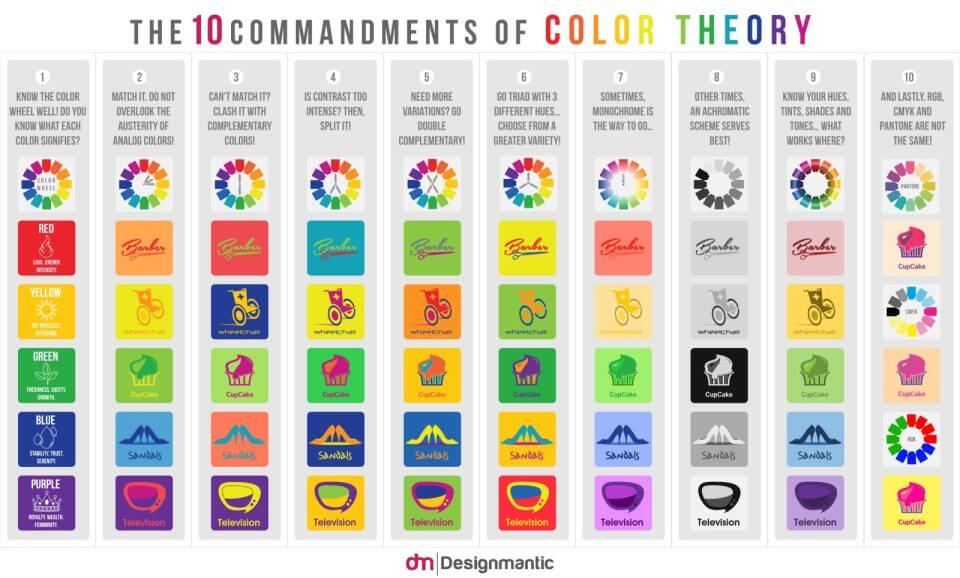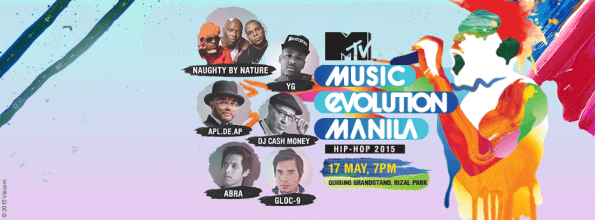Color plays a crucial role in business and branding, as it can have a significant impact on how a company is perceived by its customers and can play a role in building brand recognition and loyalty. Colors evoke different emotions and associations in people, and businesses carefully choose their branding colors to create a specific image or convey a certain message. A color can represent a brand’s values, products, or services, and it can even influence customer behavior. With so much riding on color choices, it’s important for businesses to consider the meanings of different colors and the ways they can be used to enhance their branding strategies. Understanding the psychology of color in branding can help businesses make informed decisions about their color choices and develop a more effective visual identity.
Top 15 colors, their symbolism in terms of values, the emotions they evoke, their popularity rating, reasons to use them, and their meanings in business:
| Color | Symbolism in Terms of Values | Emotions Evoked | Popularity Rating | Reasons to Use | Meaning in Business |
|---|---|---|---|---|---|
| Red | Energy, passion, danger | Excitement, anger, love | 9/10 | Attracts attention, creates urgency | Power, love, excitement, urgency |
| Blue | Trust, calmness, stability | Relaxation, trust, sadness | 9/10 | Creates a sense of security, professionalism | Trust, loyalty, calmness, professionalism |
| Green | Growth, health, nature | Tranquility, envy, rejuvenation | 8/10 | Associated with nature and eco-friendliness | Wealth, growth, health, eco-friendliness |
| Yellow | Happiness, optimism, warmth | Joy, caution, anxiety | 8/10 | Grabs attention, evokes a sense of warmth and happiness | Positivity, cheerfulness, caution |
| Orange | Creativity, enthusiasm, warmth | Excitement, caution, warmth | 7/10 | Commands attention and energy | Creativity, fun, youthfulness |
| Purple | Royalty, luxury, creativity | Spirituality, wealth, nostalgia | 7/10 | Adds a touch of elegance and sophistication | Royalty, luxury, creativity |
| Pink | Love, romance, femininity | Affection, love, happiness | 7/10 | Evokes a sense of softness and femininity | Romance, love, feminism |
| Black | Power, sophistication, elegance | Mystery, power, sadness | 9/10 | Associated with luxury and sophistication | Elegance, power, sophistication |
| White | Purity, innocence, simplicity | Peace, cleanliness, sterility | 8/10 | Creates a sense of simplicity and purity | Cleanliness, innocence, simplicity |
| Gray | Neutrality, balance, professionalism | Calmness, sadness, boredom | 6/10 | Creates a sense of professionalism and neutrality | Balance, neutrality, professionalism |
| Brown | Stability, reliability, earthiness | Warmth, dullness, boredom | 6/10 | Adds a touch of warmth and stability | Earthiness, stability, reliability |
| Beige | Calmness, simplicity, elegance | Neutrality, calmness, dullness | 6/10 | Adds a touch of elegance and simplicity | Simplicity, elegance, neutrality |
| Turquoise | Calmness, creativity, youthfulness | Serenity, creativity, immaturity | 5/10 | Evokes a sense of freshness and creativity | Creativity, serenity, youthfulness |
| Gold | Wealth, luxury, success | Opulence, glamour, excess | 5/10 | Associated with high value and luxury | Wealth, success, luxury |
| Silver | Sophistication, glamour, modernity | Elegance, high-tech, coldness | 5/10 | Adds a touch of sophistication and modernity | Sophistication, modernity, high-tech |
Note that the popularity rating is subjective and can vary depending on culture and context.
What is the importance of branding and color in Business?
Branding and color are important for businesses as they can influence customer perceptions and purchasing decisions. In fact, a study by the Institute for Color Research found that people make a subconscious judgment about a product within 90 seconds of initial viewing, and that up to 90% of that judgment is based on color alone.
One example of the importance of color in branding can be seen in the success of Coca-Cola. The company’s use of red in its branding has helped it become one of the most recognized brands in the world. According to a study by the Coca-Cola Company, their use of red in branding helps to convey feelings of excitement, passion, and energy. This has helped to build a strong emotional connection with customers and increase brand loyalty.
Another example of the importance of color in branding can be seen in the success of Starbucks. The company’s use of green in its branding helps to convey feelings of nature, sustainability, and freshness. This has helped to create a unique brand identity and build a strong emotional connection with customers. In fact, a study by the University of Maryland found that people who identify with the color green tend to be more environmentally conscious, which has helped to attract customers who value sustainability.
Overall, the importance of branding and color cannot be overstated. The right color can help to convey a brand’s values, create a strong emotional connection with customers, and increase brand recognition and loyalty. By understanding the psychology of color in branding, businesses can make informed decisions about their branding strategy and create a powerful visual identity that resonates with customers.
Looking for Real World Business Examples?
15 most used colors in business along with examples of real businesses that use them:
| Color | Real Business Examples |
|---|---|
| Blue | IBM, Facebook, Ford, GE, Dell, American Express, Intel, Samsung, HP, LinkedIn, Pfizer, Oral-B, JP Morgan, AT&T, Citibank |
| Red | Coca-Cola, KFC, Netflix, Canon, Lego, Kellogg’s, YouTube, Toyota, Virgin, CNN, ESPN, Levi’s, Time magazine, Red Bull, H&M |
| Black | Chanel, Nike, Apple, Adidas, Gucci, Puma, Ray-Ban, Zara, Yamaha, Johnnie Walker, Mercedes-Benz, Prada, Rolls-Royce, Audi, Hugo Boss |
| Green | Starbucks, Whole Foods, Animal Planet, Land Rover, Holiday Inn, BP, Android, Heineken, Spotify, Tropicana, Animal Planet, John Deere, Tic Tac, Avery Dennison, Subway |
| Yellow | McDonald’s, Best Buy, Snapchat, Ferrari, DHL, National Geographic, Caterpillar, Nikon, Hertz, Sprint, Shell, Lipton, Subway, Ferrari, Ikea |
| Orange | Amazon, Harley Davidson, SoundCloud, Fanta, Payless, Mastercard, Nickelodeon, Blogger, Firefox, The Home Depot, Hermes, Harley-Davidson, Gatorade, Adobe, Hard Rock Cafe |
| Pink | Barbie, Victoria’s Secret, Baskin Robbins, Cosmopolitan, Mary Kay, Dunkin’ Donuts, T-Mobile, NBC, Benefit Cosmetics, Pepto-Bismol, Olay, Pampers, Barbie, Lyft, Glossier |
| Brown | UPS, Hershey’s, M&M’s, J.P. Morgan, Louis Vuitton, The Coffee Bean & Tea Leaf, Timberland, Nestle, Sephora, Vans, Teddy Grahams, Milk Chocolate, Yellow Tail, Lindt, Hershey’s |
| Purple | Yahoo, Cadbury, Hallmark, Syfy, Twitch, Wonka, Crown Royal, Nivea, Barbie, Welch’s, Hallmark, Amethyst, Cadbury, Crown Royal, Wonka |
| Gray | Apple, Nike, Honda, BMW, Mercedes-Benz, Verizon, Rolex, IBM, Audi, Dove, Puma, Mastercard, Dell, Toyota, Cadillac |
| Beige | Chanel, Burberry, Louis Vuitton, Estée Lauder, Tommy Hilfiger, Celine, Tiffany & Co., MAC, Coach, Burberry, Clinique, Michael Kors, Sephora, MAC, Celine |
| Turquoise | Tiffany & Co., Twitter, T-Mobile, Tumblr, Nintendo, Ford, Skype, Ocean Spray, McAffee, Nautica, Evian, Aquafresh, Beachbody, Keurig, Jamba Juice |
| Gold | BMW, Cadillac, McDonald’s, Lexus, Rolex, American Express, Burger King, Cadillac, Ferrari, Heineken, Mastercard, Porsche, Sprite, Victoria’s Secret, Pantene |
| Silver | Mercedes-Benz, Apple, Nike, Audi, Grey Goose, Lexus, BMW, Pepsi, Nissan, LG, Microsoft, Dove, Mitsubishi, ING, Motorola |
Note that these are just a few examples of businesses that use these colors and there are many others that do as well. The choice of color in business branding can have a significant impact on how a company is perceived by its customers and can play a role in building brand recognition and loyalty.

What is the importance of Color and Branding in Schools?
Color and branding are also important in schools as they can help to create a strong visual identity, build school spirit, and promote a sense of community among students, faculty, and alumni. Here are some specific ways in which color and branding are important in schools:
- Building a strong visual identity: By choosing specific colors and designs, schools can create a distinctive visual identity that sets them apart from other schools. This can help to build brand recognition and promote a sense of pride and ownership among students and faculty.
- Fostering school spirit: By incorporating school colors and logos into uniforms, banners, and other merchandise, schools can promote a sense of unity and belonging among students, faculty, and alumni. This can help to build school spirit and create a positive school culture.
- Encouraging student engagement: By involving students in the design and implementation of branding initiatives, schools can encourage student engagement and help students to feel a sense of ownership over their school’s image.
- Attracting prospective students: A strong visual identity and branding strategy can also help schools to attract prospective students by creating a sense of excitement and intrigue. This can help to increase enrollment and promote a positive image of the school to the broader community.
Overall, color and branding are important in schools as they can help to create a strong visual identity, build school spirit, and promote a sense of community and engagement among students and faculty. By understanding the importance of color and branding in schools, educational institutions can create a powerful visual identity that resonates with their community and helps to promote their values and mission.
Looking for Schools and their Colors?
15 most used colors in school branding along with examples of real schools that use them:
| Color | Real School Examples |
|---|---|
| Blue | Yale University, University of Michigan, Duke University, UCLA, University of North Carolina, University of Virginia, University of Chicago, Columbia University, University of Pennsylvania, University of Notre Dame, University of California-Berkeley, Georgetown University, Dartmouth College, University of Oxford, Cambridge University |
| Red | Harvard University, Stanford University, University of Southern California, Boston University, Ohio State University, University of Alabama, University of Oklahoma, Texas A&M University, Rutgers University, University of Georgia, University of Louisville, Arizona State University, University of Nebraska, University of Maryland, University of Cincinnati |
| Black | New York University, University of Louisville, University of Oregon, Villanova University, Carnegie Mellon University, University of Arkansas, University of Akron, Howard University, University of Texas-Austin, University of Pittsburgh, University of New Mexico, Georgia Tech, University of Tulsa, University of South Carolina, Wake Forest University |
| Green | University of California-San Diego, University of Miami, Michigan State University, Dartmouth College, University of Wisconsin-Madison, University of North Texas, University of Oregon, University of Missouri, University of Wyoming, University of South Florida, Appalachian State University, University of California-Santa Cruz, University of Colorado-Boulder, University of Alabama-Birmingham, University of Vermont |
| Yellow | Massachusetts Institute of Technology, University of California-Berkeley, Purdue University, Clemson University, University of Iowa, University of Colorado-Denver, Northern Arizona University, California State University-Sacramento, Northern Illinois University, Texas Tech University, Northeastern University, University of Missouri-Kansas City, University of North Carolina-Asheville, University of Iowa, South Dakota State University |
| Orange | Syracuse University, University of Tennessee, Auburn University, University of Illinois-Chicago, University of Florida, Clemson University, University of Texas-San Antonio, Virginia Tech, University of Virginia, Boise State University, University of Texas-El Paso, University of Texas-Dallas, University of Tulsa, University of California-Irvine, University of New Orleans |
| Pink | Sweet Briar College, Wellesley College, Hollins University, Stephens College, Mary Baldwin University, Scripps College, Agnes Scott College, Smith College, Randolph College, Randolph-Macon College, Bryn Mawr College, Mills College, Wesleyan College, Spelman College, Mount Holyoke College |
| Brown | Brown University, University of Wyoming, University of Idaho, Boston College, Marquette University, Colgate University, University of Houston, Columbia University, Southern Illinois University, Boston University, Purdue University, University of Cincinnati, Northern Michigan University, Case Western Reserve University, University of Utah |
| Purple | Northwestern University, Syracuse University, New York University, Louisiana State University, Kansas State University, Furman University, Western Kentucky University, University of Washington, Brigham Young University, University of Minnesota, University of Evansville, University of Central Florida, University of Houston-Downtown, University of Colorado-Colorado Springs, Lincoln University |
| Gray | Princeton University, University of Maryland, University of Central Arkansas, California State University-Long Beach, Southern Utah University, Central Connecticut State University, Eastern Illinois University, Southern Illinois University-Edwardsville, San Francisco State University, Arkansas Tech University, University of West Georgia, University of North Dakota, California State University-Bakersfield, University of Texas-Arlington, Grand Valley State University |
| Beige | Cornell University, University of Virginia, Colby College, Wake Forest University, Hamilton College, University of Dayton, University of San Francisco, Southern Methodist University |
| Turquoise | University of Arizona, University of North Texas, University of Montana, Montana State University, University of Texas-Rio Grande Valley, University of Texas-Pan American, University of Hawaii-Hilo, University of Central Oklahoma, University of Northern Colorado, Trinity University, University of Hawaii-Manoa, University of Texas-Permian Basin, Texas A&M International University, University of Southern Mississippi, Texas State University | |
| Gold | University of Notre Dame, Purdue University, University of Iowa, University of Southern Mississippi, University of North Carolina-Charlotte, University of California-Merced, University of Missouri-St. Louis, University of Central Florida, Florida Atlantic University, Florida International University, University of South Florida-Sarasota, Florida Gulf Coast University, University of Louisiana-Lafayette, University of Tulsa, University of Southern Indiana |
| Silver | University of California-San Francisco, University of Southern Indiana, University of North Dakota, University of Texas-San Antonio, University of Nevada-Las Vegas, Texas A&M University-Commerce, West Virginia University, University of Alaska-Fairbanks, University of South Carolina-Beaufort, University of Southern Mississippi, Eastern Kentucky University, University of Central Missouri, Texas A&M University-Kingsville, University of North Alabama, South Dakota State University. |
Note that these are just a few examples of schools that use these colors and there are many others that do as well. The choice of color in school branding can have a significant impact on how a school is perceived by its students, faculty, and alumni, and can play a role in building school spirit and loyalty.
Schools in the Philippines and their Colors and Meaning.
Color plays a significant role in schools’ visual identity and branding. By using specific colors, schools can create a unique and recognizable visual identity that reflects their values, traditions, and personality. Color can help to create a positive emotional connection with students, faculty, and alumni, and foster a sense of pride and belonging within the school community.
The meaning of color in school identity can vary depending on the culture, location, and history of the school. For example, the color green may represent growth, harmony, and progress in one school, while it may represent tradition and academic excellence in another. Similarly, the color blue may represent trust, intelligence, and loyalty in one school, while it may represent creativity and innovation in another.
In today’s competitive educational landscape, creating a strong visual identity through color can help schools to stand out and attract prospective students. By understanding the meaning of color in school identity and the psychology behind color choices, schools can create a visual identity that resonates with their community and reflects their unique values and personality.
Here’s a table of 15 schools in the Philippines, their branding colors, and their meanings:
| School | Color | Meaning |
|---|---|---|
| Ateneo de Manila University | Blue, White | Blue represents loyalty, integrity, and excellence, while white represents purity and honesty. |
| De La Salle University | Green, White | Green represents growth, prosperity, and progress, while white represents purity and integrity. |
| University of the Philippines | Maroon, Green | Maroon represents leadership, innovation, and tradition, while green represents growth, harmony, and progress. |
| University of Santo Tomas | Gold, Black, White | Gold represents excellence, wealth, and success, while black represents elegance and professionalism, and white represents purity and simplicity. |
| Far Eastern University | Gold, Green | Gold represents excellence, achievement, and success, while green represents growth, harmony, and progress. |
| Adamson University | Blue, White | Blue represents loyalty, trust, and intelligence, while white represents purity and honesty. |
| University of the East | Red, White | Red represents passion, energy, and strength, while white represents purity and honesty. |
| Mapua University | Red, Yellow, White | Red represents strength, passion, and courage, yellow represents creativity and innovation, and white represents purity and clarity. |
| Lyceum of the Philippines University | Blue, White | Blue represents loyalty, wisdom, and truth, while white represents purity and clarity. |
| Philippine Normal University | Red, White | Red represents passion, energy, and leadership, while white represents purity and honesty. |
| Polytechnic University of the Philippines | Blue, Yellow, White | Blue represents intelligence, stability, and trust, yellow represents creativity and innovation, and white represents purity and clarity. |
| San Beda University | Red, White | Red represents passion, leadership, and courage, while white represents purity and simplicity. |
| University of the East – Ramon Magsaysay Memorial Medical Center | Blue, Gold, White | Blue represents loyalty, trust, and intelligence, gold represents success and achievement, and white represents purity and honesty. |
| Saint Louis University | Green, Gold | Green represents growth, harmony, and progress, while gold represents success and achievement. |
| University of San Carlos | Green, Gold, White | Green represents growth, harmony, and progress, gold represents excellence and achievement, and white represents purity and honesty. |
Note that these are just a few examples of schools in the Philippines and their branding colors, and that the meanings of colors can vary depending on culture and context.

What is the color theory and can it be applied to Business?
Color theory is the study of how colors interact with each other and with people’s emotions and perceptions. It includes principles such as color harmony, color contrast, color psychology, and color symbolism.
Color theory can certainly be applied to business, as color plays a significant role in branding, marketing, and product design. By understanding the principles of color theory, businesses can make informed decisions about their branding and marketing strategies, and create a visual identity that resonates with their target audience.
For example, businesses can use color theory to create a color palette that is visually appealing and communicates their brand’s values and personality. They can also use color psychology to influence customer perceptions and emotions, and color symbolism to reinforce their brand’s messaging and values.
Additionally, businesses can use color contrast and harmony to create a strong visual impact in their marketing materials and product design, and ensure that their branding is consistent across all channels.
Overall, color theory can be a powerful tool for businesses looking to create a strong visual identity, build brand recognition and loyalty, and influence customer behavior. By applying the principles of color theory to their branding and marketing strategies, businesses can create a powerful and effective visual identity that resonates with their target audience.
Here’s a table explaining the basic principles of color theory and their applications in branding and design:
| Principle | Definition | Application in Branding and Design |
|---|---|---|
| Color Wheel | A visual representation of the spectrum of colors, arranged in a circular shape. | Used to create color schemes and combinations that are visually appealing and harmonious. |
| Primary Colors | The three colors that cannot be created by mixing other colors: red, yellow, and blue. | Used as the basis for all color mixing and combinations. |
| Secondary Colors | The colors created by mixing two primary colors: orange, green, and purple. | Used to create more complex color schemes and combinations. |
| Tertiary Colors | The colors created by mixing a primary color with a secondary color. | Used to create more nuanced and sophisticated color schemes and combinations. |
| Color Harmony | The use of colors that are visually pleasing and balanced. | Used to create a cohesive and aesthetically pleasing visual identity that communicates a brand’s values and personality. |
| Color Contrast | The use of colors that are visually distinct from each other. | Used to create visual interest and impact in marketing materials and product design. |
| Color Psychology | The study of how colors influence people’s emotions and perceptions. | Used to choose colors that reinforce a brand’s messaging and values, and influence customer behavior. |
| Color Symbolism | The use of colors to represent certain ideas or concepts. | Used to reinforce a brand’s messaging and values, and create a visual language that resonates with customers. |
Note that these are just a few examples of the basic principles of color theory, and that there are many other nuances and applications to consider when working with color in branding and design. By understanding the principles of color theory and their applications, businesses can create a powerful visual identity that resonates with their target audience and helps to build brand recognition and loyalty.
Conclusion
In conclusion, symbolism in color can have a significant impact on business and can be used to communicate a wide range of messages and values to customers. The meanings of colors can vary depending on culture and context, but businesses can use color psychology and symbolism to create a strong visual identity that resonates with their target audience.
By understanding the symbolism and meanings of different colors, businesses can make informed decisions about their branding and marketing strategies, and create a visual identity that communicates their values and personality effectively. For example, the color blue is often associated with trust, professionalism, and intelligence, while the color red is associated with passion, excitement, and energy.
In addition, the colors that are most popular or commonly used in a specific industry can also provide insights into what the future may hold for businesses operating in that industry. By keeping track of color trends and using them to inform their branding and marketing strategies, businesses can position themselves for success and stay ahead of the competition.
Overall, the symbolism and meaning of color in business can be a powerful tool for building brand recognition, loyalty, and trust among customers. By understanding the psychology of color and its potential impact on customer behavior, businesses can create a strong visual identity that resonates with their target audience and helps them achieve their business goals.
























